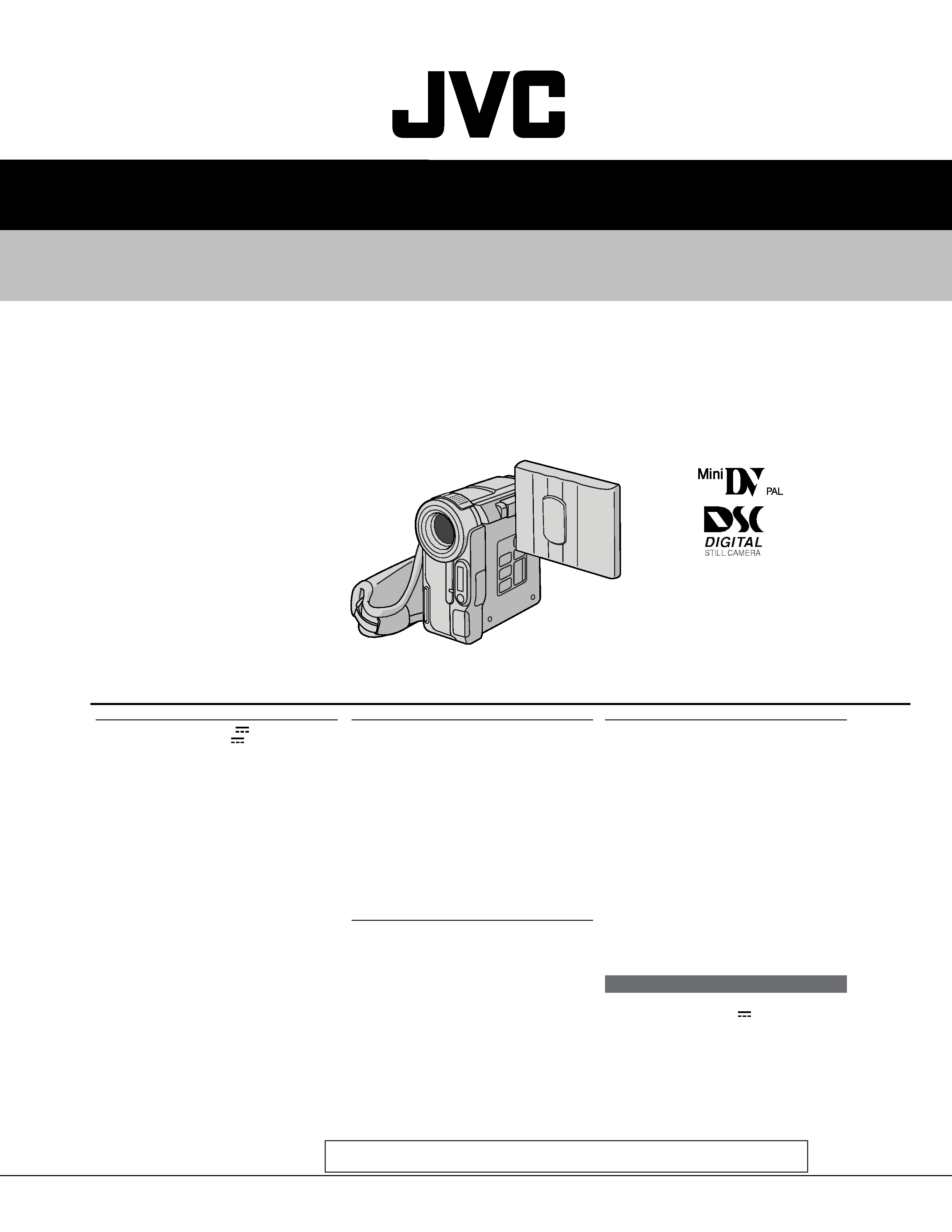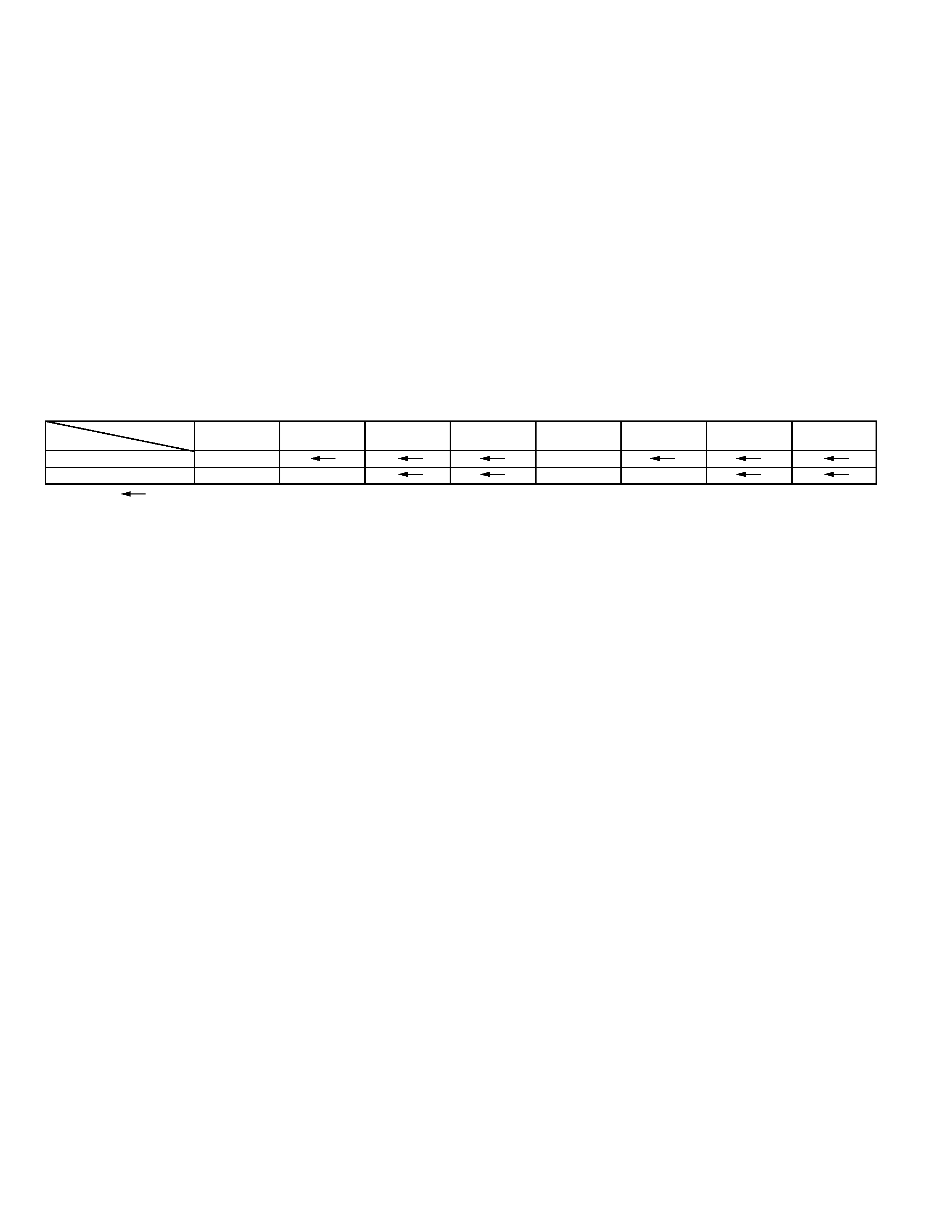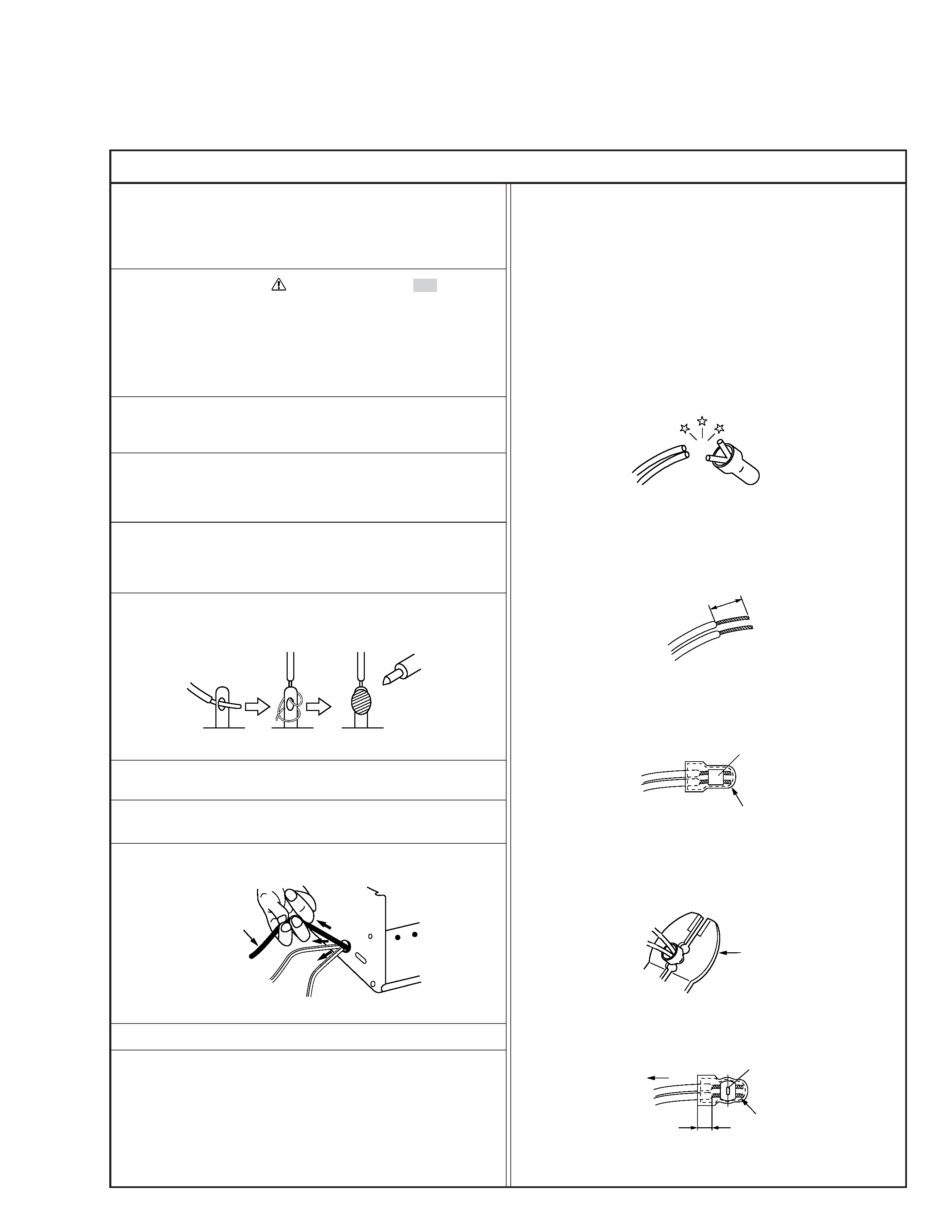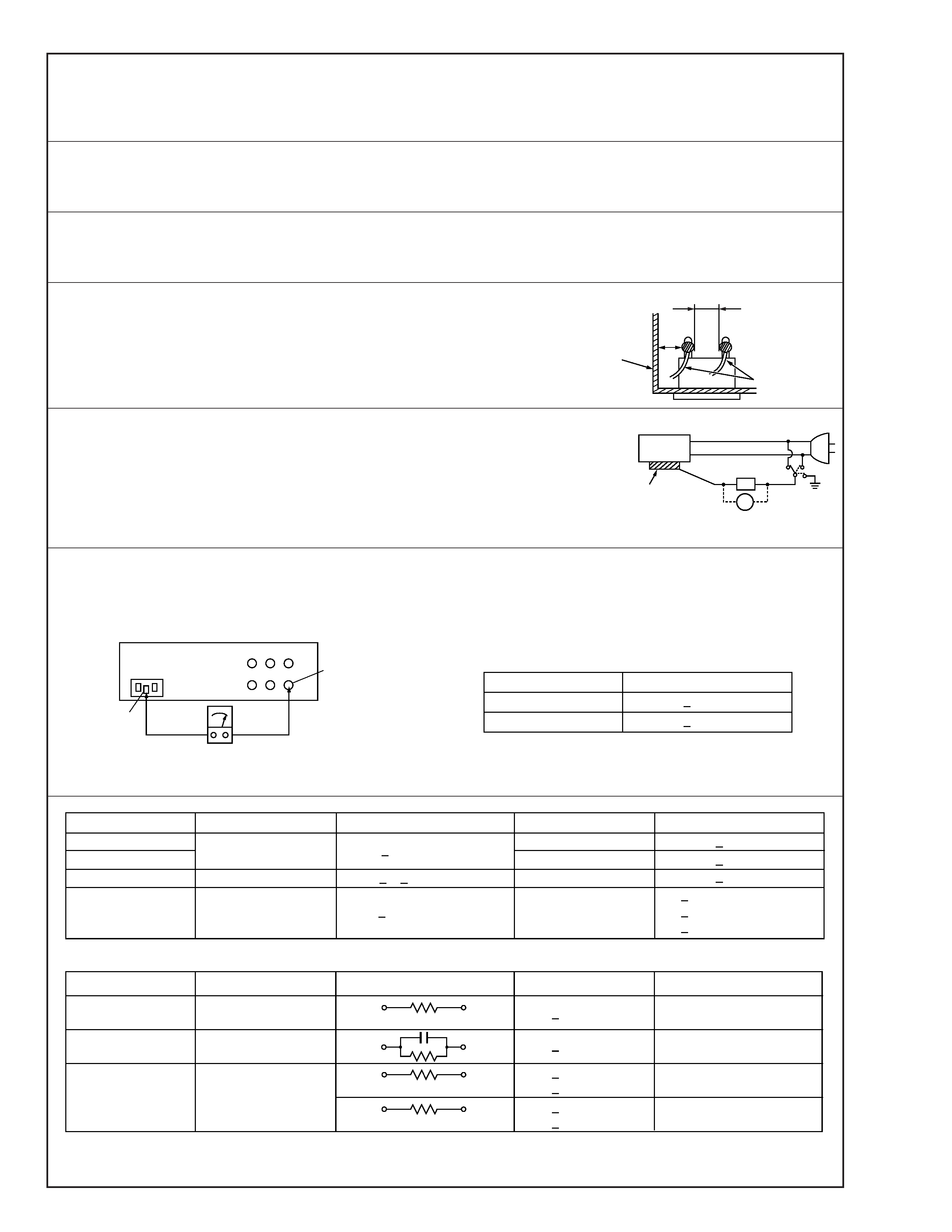
COPYRIGHT © 2003 VICTOR COMPANY OF JAPAN, LTD
SERVICE MANUAL
For disassembling and assembling of MECHANISM ASSEMBLY, refer to the SERVICE MANUAL No.86700(MECHANISM ASSEMBLY).
General
Power supply
: DC 11.0 V
(Using AC Adapter)
DC 7.2 V
(Using battery pack)
Power consumption
LCD monitor off,
viewfinder on : Approx. 3.4 W
LCD monitor on,
viewfinder off : Approx. 4.6 W
Dimensions
(W x H x D)
: 55 mm x 102 mm x 96 mm
(with the LCD monitor closed and
the viewfinder pushed back in)
Weight
: Approx. 440 g (GR-DX300/DX100)
(without grip belt)
: Approx. 450 g (GR-DX95/DX75)
(without grip belt)
Operating
temperature
:0
°C to 40°C
Operating
humidity
: 35% to 80%
Storage
temperature
: 20
°C to 50°C
Pickup
: 1/4" CCD (GR-DX300/DX100)
1/6" CCD (GR-DX95/DX75)
Lens
: F 1.8, f = 3.8 mm to 38 mm,
10:1 power zoom lens
(GR-DX300/DX100)
F1.6, f =2.7 mm to 43.2 mm,
16:1 power zoom lens
(GR-DX95/DX75)
Filter diameter
: ø30.5 mm
LCD monitor
: 3" diagonally measured, LCD
panel/TFT active matrix system
(GR-DX300/DX95)
2.5" diagonally measured, LCD
panel/TFT active matrix system
(GR-DX100/DX75)
Viewfinder
: Electronic viewfinder with 0.24"
black/white LCD
Speaker
: Monaural
Digital Video Camera
Format
: DV format (SD mode)
Signal format
: PAL standard
Recording/
Playback format : Video: Digital component
recording
: Audio: PCM digital recording,
32 kHz 4-channel (12-bit),
48 kHz 2-channel (16-bit)
Cassette
: Mini DV cassette
Tape speed
: SP : 18.8 mm/s
LP : 12.5 mm/s
Maximum
recording time
: SP : 80 min.
(using 80 min.
LP : 120 min.
cassette)
Digital Still Camera Function
Storage media
: SD Memory Card/MultiMediaCard
Compression
system
: Still image
: JPEG
(compatible)
Moving image : MPEG4
(compatible)
File size
: 4 modes (1600 x 1200 pixels*,
1280 x 960 pixels*,
1024 x 768 pixels,
640 x 480 pixels)
Picture quality
: 2 modes (FINE/STANDARD)
Approximate
number of
storable images :
pg. 18.
* GR-DX300/DX100 only.
Connectors
S/AV
S-Video output
: Y : 1 V (p-p), 75
, analogue
C : 0.29 V (p-p), 75
, analogue
S-Video input
: Y : 0.8 V (p-p) 1.2 V (p-p), 75
,
analogue
C : 0.2 V (p-p) 0.4 V (p-p), 75
,
analogue
Video output
: 1 V (p-p), 75
, analogue
Video input
: 0.8 V (p-p) 1.2 V (p-p), 75
,
analogue
Audio output
: 300 mV (rms), 1 k
, analogue,
stereo
Audio input
: 300 mV (rms), 50 k
, analogue,
stereo
Edit
: ø3.5 mm, 2-pole
DV
Output
: 4-pin, IEEE 1394 compliant
Input
: 4-pin, IEEE 1394 compliant
USB
: 5-pin
AC Adapter
Power requirement : AC 110 V to 240 V`, 50 Hz/60 Hz
Output
: DC 11 V
, 1 A
Specifications shown are for SP mode unless otherwise indicated. E & O.E. Design and specifications subject
to change without notice.
No.86740
2003/06
GR-DX75EX, GR-DX75EY, GR-DX75EZ, GR-DX75EK,
GR-DX95EX, GR-DX95EY, GR-DX95EZ, GR-DX95EK
GR-DX75EK M3D327
GR-DX75EX M3D327
GR-DX75EY M3D327
GR-DX75EZ M3D327
GR-DX95EK M3D337
GR-DX95EX M3D337
GR-DX95EY M3D337
GR-DX95EZ M3D337
DIGITAL VIDEO CAMERA
SPECIFICATIONS (The specifications shown pertain specifically to the model GR-DX75EX, GR-DX95EX, GR-DX100EX and GR-DX300EX.)

CONTENTS
Important Safety Precautions
1.
DISASSEMBLY ............................................................................................................................................................... 1-1
3.
ADJUSTMENT ................................................................................................................................................................ 3-1
4.
CHARTS AND DIAGRAMS ............................................................................................................................................ 4-1
5.
PARTS LIST .................................................................................................................................................................... 5-1
The following table indicate main different points between models GR-DX75EK, GR-DX75EX, GR-DX75EY, GR-DX75EZ, GR-
DX95EK, GR-DX95EX, GR-DX95EY and GR-DX95EZ.
DIFFERENT LIST
DIFFERENT TABLE OF FEATURE
Notes: Mark
is same as left.
MODEL
GR-DX75EK
ITEM
LCD MONITOR
2.5 INCH
3.0 INCH
AC CORD
BS PLUG
CEE PLUG
BS PLUG
CEE PLUG
GR-DX75EX GR-DX75EY GR-DX75EZ GR-DX95EK GR-DX95EX GR-DX95EY GR-DX95EZ

Important Safety Precautions
Prior to shipment from the factory, JVC products are strictly inspected to conform with the recognized product safety and electrical codes
of the countries in which they are to be sold. However, in order to maintain such compliance, it is equally important to implement the
following precautions when a set is being serviced.
Fig.1
1. Locations requiring special caution are denoted by labels and
inscriptions on the cabinet, chassis and certain parts of the
product. When performing service, be sure to read and com-
ply with these and other cautionary notices appearing in the
operation and service manuals.
2. Parts identified by the
symbol and shaded (
) parts are
critical for safety.
Replace only with specified part numbers.
Note: Parts in this category also include those specified to com-
ply with X-ray emission standards for products using
cathode ray tubes and those specified for compliance
with various regulations regarding spurious radiation
emission.
3. Fuse replacement caution notice.
Caution for continued protection against fire hazard.
Replace only with same type and rated fuse(s) as specified.
4. Use specified internal wiring. Note especially:
1) Wires covered with PVC tubing
2) Double insulated wires
3) High voltage leads
5. Use specified insulating materials for hazardous live parts.
Note especially:
1) Insulation Tape
3) Spacers
5) Barrier
2) PVC tubing
4) Insulation sheets for transistors
6. When replacing AC primary side components (transformers,
power cords, noise blocking capacitors, etc.) wrap ends of
wires securely about the terminals before soldering.
Power cord
Fig.2
10. Also check areas surrounding repaired locations.
11. Products using cathode ray tubes (CRTs)
In regard to such products, the cathode ray tubes themselves,
the high voltage circuits, and related circuits are specified for
compliance with recognized codes pertaining to X-ray emission.
Consequently, when servicing these products, replace the cath-
ode ray tubes and other parts with only the specified parts.
Under no circumstances attempt to modify these circuits.
Unauthorized modification can increase the high voltage value
and cause X-ray emission from the cathode ray tube.
12. Crimp type wire connector
In such cases as when replacing the power transformer in sets
where the connections between the power cord and power
transformer primary lead wires are performed using crimp type
connectors, if replacing the connectors is unavoidable, in or-
der to prevent safety hazards, perform carefully and precisely
according to the following steps.
1) Connector part number : E03830-001
2) Required tool : Connector crimping tool of the proper type
which will not damage insulated parts.
3) Replacement procedure
(1) Remove the old connector by cutting the wires at a point
close to the connector.
Important : Do not reuse a connector (discard it).
Fig.7
cut close to connector
Fig.3
(2) Strip about 15 mm of the insulation from the ends of
the wires. If the wires are stranded, twist the strands to
avoid frayed conductors.
15 mm
Fig.4
(3) Align the lengths of the wires to be connected. Insert
the wires fully into the connector.
Connector
Metal sleeve
Fig.5
(4) As shown in Fig.6, use the crimping tool to crimp the
metal sleeve at the center position. Be sure to crimp fully
to the complete closure of the tool.
1
Precautions during Servicing
7. Observe that wires do not contact heat producing parts
(heatsinks, oxide metal film resistors, fusible resistors, etc.)
8. Check that replaced wires do not contact sharp edged or
pointed parts.
9. When a power cord has been replaced, check that 10-15 kg of
force in any direction will not loosen it.
1.25
2.0
5.5
Crimping tool
Fig.6
(5) Check the four points noted in Fig.7.
Not easily pulled free
Crimped at approx. center
of metal sleeve
Conductors extended
Wire insulation recessed
more than 4 mm
S40888-01

Safety Check after Servicing
Examine the area surrounding the repaired location for damage or deterioration. Observe that screws, parts and wires have been
returned to original positions, Afterwards, perform the following tests and confirm the specified values in order to verify compli-
ance with safety standards.
1. Insulation resistance test
Confirm the specified insulation resistance or greater between power cord plug prongs and
externally exposed parts of the set (RF terminals, antenna terminals, video and audio input
and output terminals, microphone jacks, earphone jacks, etc.). See table 1 below.
2. Dielectric strength test
Confirm specified dielectric strength or greater between power cord plug prongs and exposed
accessible parts of the set (RF terminals, antenna terminals, video and audio input and output
terminals, microphone jacks, earphone jacks, etc.). See table 1 below.
3. Clearance distance
When replacing primary circuit components, confirm specified clearance distance (d), (d') be-
tween soldered terminals, and between terminals and surrounding metallic parts. See table 1
below.
4. Leakage current test
Confirm specified or lower leakage current between earth ground/power cord plug prongs
and externally exposed accessible parts (RF terminals, antenna terminals, video and audio
input and output terminals, microphone jacks, earphone jacks, etc.).
Measuring Method : (Power ON)
Insert load Z between earth ground/power cord plug prongs and externally exposed accessi-
ble parts. Use an AC voltmeter to measure across both terminals of load Z. See figure 9 and
following table 2.
5. Grounding (Class 1 model only)
Confirm specified or lower grounding impedance between earth pin in AC inlet and externally exposed accessible parts (Video in,
Video out, Audio in, Audio out or Fixing screw etc.).
Measuring Method:
Connect milli ohm meter between earth pin in AC inlet and exposed accessible parts. See figure 10 and grounding specifications.
d'
d
Chassis
Power cord,
primary wire
Region
USA & Canada
Europe & Australia
Grounding Impedance (Z)
Z
0.1 ohm
Z
0.5 ohm
AC inlet
Earth pin
Exposed accessible part
Milli ohm meter
Grounding Specifications
Fig. 10
ab
c
V
Externally
exposed
accessible part
Z
Fig. 9
Fig. 8
Clearance Distance (d), (d')
d, d'
3 mm
d, d'
4 mm
d, d'
3.2 mm
1 M
R 12 M/500 V DC
Dielectric Strength
AC 1 kV 1 minute
AC 1.5 kV 1 miute
AC 1 kV 1 minute
AC Line Voltage
100 V
100 to 240 V
110 to 130 V
110 to 130 V
200 to 240 V
Japan
USA & Canada
Europe & Australia
R
10 M
/500 V DC
Region
Insulation Resistance (R)
R
1 M
/500 V DC
AC 3 kV 1 minute
(Class
2)
AC 1.5 kV 1 minute
(Class
1)
d
4 mm
d'
8 mm (Power cord)
d'
6 mm (Primary wire)
Table 1 Specifications for each region
a, b, c
Leakage Current (i)
AC Line Voltage
100 V
110 to 130 V
110 to 130 V
220 to 240 V
Japan
USA & Canada
i
1 mA rms
Exposed accessible parts
Exposed accessible parts
Antenna earth terminals
Other terminals
i
0.5 mA rms
i
0.7 mA peak
i
2 mA dc
i
0.7 mA peak
i
2 mA dc
Europe & Australia
Region
Load Z
1 k
2 k
1.5 k
0.15
µF
50 k
Table 2 Leakage current specifications for each region
Note: These tables are unofficial and for reference only. Be sure to confirm the precise values for your particular country and locality.
2
S40888-01

1-1
SECTION 1
DISASSEMBLY
1.1 Before disassembling
1.1.1
Precaution
·
Be sure to disconnect the power supply unit prior to mount-
ing and soldering of parts.
·
Prior to removing a component part that needs to discon-
nect its connector(s) and its screw(s), first disconnect the
wire(s) from the connector(s), and then remove the screw(s).
·
Be careful not to damage the connector and wire etc. dur-
ing connection and disconnection.
·
When connecting the flat wire to the connector, be careful
with the flat wire direction.
·
Be careful in removing or handling the part to which some
spacer or shield is attached for reinforcement or insulation.
·
When replacing chip parts (especially IC parts), first remove
the solder completely to prevent peeling of the pattern.
·
Tighten screws properly during the procedures. Unless
specified otherwise, tighten screws at a torque of 0.078Nom
(0.8kgfocm).
·
The bracketed ( ) WR of the connector symbol are assigned
nos. in priority order and do not correspond to those on the
spare parts list.
1.1.2 Disconnection of connectors (wires)
· Torque driver
Be sure to use to fastening the mechanism and exterior parts
because those parts must strictly be controlled for tighten-
ing torque.
· Bit
This bit is slightly longer than those set in conventional torque
drivers.
· Tweezers
To be used for removing and installing parts and wires.
· Chip IC replacement jig
To be used for replacement of IC.
· Cleaning cloth
Recommended the Cleaning cloth to wipe down the video
heads, mechanism (tape transport system), optical lens sur-
face.
FPC connector
Flat wire
FPC connector
lock
Flat wire
B-B connector
B-B connector
B-B connector
· Extend the locks in the direction of the arrow for
unlocking and then pull out the wire. After re-
moving the wire, immediately restore the locks
to their original positions because the locks are
apt to come off the connector.
· Pull both ends of the connector in the arrow
direction, remove the lock and disconnect
the flat wire.
· Pull the board by both the sides in the direction of
the arrow for disconnecting the B-B connector.
Fig. 1-1-2a CONNECTOR
1.1.3
Required disassembling tools
Cleaning cloth
KSMM-01
Torque driver
YTU94088
Bit
YTU94088-003
Chip IC replacement jig
PTS40844-2
Tweezers
P-895
Fig. 1-1-3a
1.2 Removing the major parts
1.2.1 How to read the procedure table
This table shows the steps for disassembly of the major parts.
Reverse these steps when re-assembling them.
<Example>
(*1) Order of steps in Procedure
When reassembling, perform the step(s) in the reverse or-
der.
(*2) Part name to be removed or installed.
(*3) Fig. No. showing procedure or part location.
(*4) Identification of part to be removed, unhooked, unlocked,
released, unplugged, unclamped or unsoldered.
P= Spring, W= Washer, S= Screw, L= Locking tab, SD=
Solder, CN**(WR**)= Remove the wire (WR**) from the con-
nector (CN**).
(*5) Adjustment information for installation
(*1)
(*2)
(*3)
(*4)
(*5)
Step
No.
Part Name
Fig. No.
Point
Note
[1]
Top cover,
1-3a 4(S1a),(S1b),3(L1a),
<Note 1a>
2(SD1a),(P1a),(W1a),
CN1(WR1a),
Bracket
2(S1c)
--------------------------
